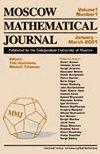平面上实解析向量场的分离度
IF 0.5
4区 数学
Q3 MATHEMATICS
引用次数: 1
摘要
设$X$为在$({\mathbb R}^{2},0)$处具有代数孤立奇点的实解析向量场的胚芽。如果$X$的奇异性约简中不存在拓扑鞍节点,则称其为拓扑广义曲线。在这种情况下,我们证明了如果阶$\nu_{0}(X)$或米尔诺数$\mu_{0}(X)$是偶的,那么$X$有一个形式分离矩阵,即在$0 \in {\mathbb R}^{2}$处有一个形式不变曲线。这个结果是最优的,因为这些假设不能保证存在一个收敛的分离矩阵。本文章由计算机程序翻译,如有差异,请以英文原文为准。
Separatrices for Real Analytic Vector Fields in the Plane
Let $X$ be a germ of real analytic vector field at $({\mathbb R}^{2},0)$ with an algebracally isolated singularity. We say that $X$ is a topological generalized curve if there are no topological saddle-nodes in its reduction of singularities. In this case, we prove that if either the order $\nu_{0}(X)$ or the Milnor number $\mu_{0}(X)$ is even, then $X$ has a formal separatrix, that is, a formal invariant curve at $0 \in {\mathbb R}^{2}$. This result is optimal, in the sense that these hypotheses do not assure the existence of a convergent separatrix.
求助全文
通过发布文献求助,成功后即可免费获取论文全文。
去求助
来源期刊
CiteScore
1.40
自引率
0.00%
发文量
16
审稿时长
>12 weeks
期刊介绍:
The Moscow Mathematical Journal (MMJ) is an international quarterly published (paper and electronic) by the Independent University of Moscow and the department of mathematics of the Higher School of Economics, and distributed by the American Mathematical Society. MMJ presents highest quality research and research-expository papers in mathematics from all over the world. Its purpose is to bring together different branches of our science and to achieve the broadest possible outlook on mathematics, characteristic of the Moscow mathematical school in general and of the Independent University of Moscow in particular.
An important specific trait of the journal is that it especially encourages research-expository papers, which must contain new important results and include detailed introductions, placing the achievements in the context of other studies and explaining the motivation behind the research. The aim is to make the articles — at least the formulation of the main results and their significance — understandable to a wide mathematical audience rather than to a narrow class of specialists.

 求助内容:
求助内容: 应助结果提醒方式:
应助结果提醒方式:


